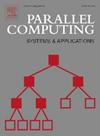Enable cross-iteration parallelism for PIM-based graph processing with vertex-level synchronization
IF 2.1
4区 计算机科学
Q2 COMPUTER SCIENCE, THEORY & METHODS
引用次数: 0
Abstract
Processing-in-memory (PIM) architectures have emerged as a promising solution for accelerating graph processing by enabling computation in memory and minimizing data movement. However, most existing PIM-based graph processing systems rely on the Bulk Synchronous Parallel (BSP) model, which frequently enforces global barriers that limit cross-iteration computational parallelism and introduce significant synchronization and communication overheads.
To address these limitations, we propose the Cross Iteration Parallel (CIP) model, a novel vertex-level synchronization approach that eliminates global barriers by independently tracking the synchronization states of vertices. The CIP model enables concurrent execution across iterations, enhancing computational parallelism, overlapping communication and computation, improving core utilization, and increasing resilience to workload imbalance. We implement the CIP model in a PIM-based graph processing system, GraphDF, which features a few specially designed function units to support vertex-level synchronization. Evaluated on a PyMTL3-based cycle-accurate simulator using four real-world graphs and four graph algorithms, CIP running on GraphDF achieves an average speedup of 1.8 and a maximum of 2.3 compared to Dalorex, the state-of-the-art PIM-based graph processing system.
为顶点级同步的基于pim的图形处理启用交叉迭代并行性
内存中处理(PIM)架构已经成为一种很有前途的解决方案,可以通过在内存中进行计算和最小化数据移动来加速图形处理。然而,大多数现有的基于pim的图形处理系统依赖于批量同步并行(BSP)模型,该模型经常强制执行全局障碍,限制了交叉迭代计算并行性,并引入了显著的同步和通信开销。为了解决这些限制,我们提出了交叉迭代并行(CIP)模型,这是一种新的顶点级同步方法,通过独立跟踪顶点的同步状态来消除全局障碍。CIP模型支持跨迭代的并发执行,增强计算并行性、重叠通信和计算、提高核心利用率,并增加对工作负载不平衡的弹性。我们在基于pim的图形处理系统GraphDF中实现了CIP模型,该系统具有几个专门设计的功能单元来支持顶点级同步。在基于pymtl3的周期精确模拟器上使用四个真实世界的图形和四种图形算法进行评估,与最先进的基于pim的图形处理系统Dalorex相比,在GraphDF上运行的CIP实现了1.8倍的平均加速,最大加速为2.3倍。
本文章由计算机程序翻译,如有差异,请以英文原文为准。
求助全文
约1分钟内获得全文
求助全文
来源期刊

Parallel Computing
工程技术-计算机:理论方法
CiteScore
3.50
自引率
7.10%
发文量
49
审稿时长
4.5 months
期刊介绍:
Parallel Computing is an international journal presenting the practical use of parallel computer systems, including high performance architecture, system software, programming systems and tools, and applications. Within this context the journal covers all aspects of high-end parallel computing from single homogeneous or heterogenous computing nodes to large-scale multi-node systems.
Parallel Computing features original research work and review articles as well as novel or illustrative accounts of application experience with (and techniques for) the use of parallel computers. We also welcome studies reproducing prior publications that either confirm or disprove prior published results.
Particular technical areas of interest include, but are not limited to:
-System software for parallel computer systems including programming languages (new languages as well as compilation techniques), operating systems (including middleware), and resource management (scheduling and load-balancing).
-Enabling software including debuggers, performance tools, and system and numeric libraries.
-General hardware (architecture) concepts, new technologies enabling the realization of such new concepts, and details of commercially available systems
-Software engineering and productivity as it relates to parallel computing
-Applications (including scientific computing, deep learning, machine learning) or tool case studies demonstrating novel ways to achieve parallelism
-Performance measurement results on state-of-the-art systems
-Approaches to effectively utilize large-scale parallel computing including new algorithms or algorithm analysis with demonstrated relevance to real applications using existing or next generation parallel computer architectures.
-Parallel I/O systems both hardware and software
-Networking technology for support of high-speed computing demonstrating the impact of high-speed computation on parallel applications
 求助内容:
求助内容: 应助结果提醒方式:
应助结果提醒方式:


